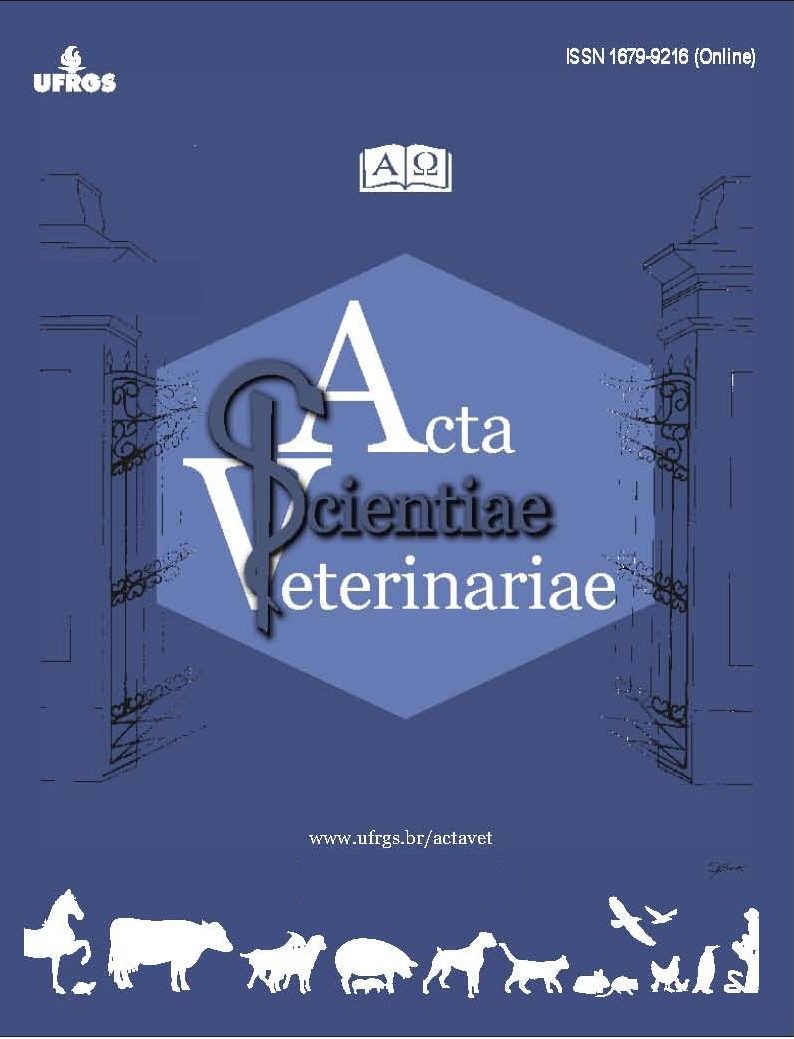Unilateral Renal Agenesis in a Bitch
DOI:
https://doi.org/10.22456/1679-9216.126911Abstract
Background: Nephropathies are generalizations that indicate kidney disease or injury, which eventually can lead to some type of kidney failure. A rare condition in dogs, renal agenesis can be bilateral or unilateral, the former being incompatible with postnatal life. Unilateral renal agenesis is commonly asymptomatic and is accompanied by hypertrophy of the remaining kidney. Ipsilateral ureteral agenesis may also be seen to the absent kidney, the ureter may be absent or malformed with a blunt end ending in connective tissue. The aim of this report is to describe a case of renal agenesis in an adult bitch.
Case: An approximately 5-year-old spayed bitch mixed-breed, was seen for consultation and preoperative exams, in order to perform an elective periodontal cleaning procedure. The animal had a history of ovariosalpingohysterectomy without previous laboratory tests. Imaging tests were also performed. In the ultrasound examination, the absence of the right kidney was found, and the other organs had a normal appearance. A 2 nd ultrasound and radiography performed later showed the absence of a functional right kidney and its remains. In both exams, the left kidney was within an apparent normality. During the radiographic examination, no silhouette or structure consistent with the right kidney was observed.
Discussion: The etiopathogenesis of renal agenesis in companion animals is still uncertain, but genetic predisposition has
been identified mainly in Beagle dogs, as well as in Shetland Sheepdogs and Doberman Pinschers. In agreement with the
present case report, the kidney should be retroperitoneally compressed against the dorsal abdominal wall, more cranial in relation to the left kidney, predominantly in the lumbar region, projecting cranially to the intrathoracic part of the abdo
men. As renal function can be sustained when up to 75% of the organ is affected, unilateral agenesis can go unnoticed
during the animal’s life, being found by chance in routine examinations or during necropsy. This is due in most cases to the compensatory hypertrophy of the other kidney, with an increase in the glomerular filtration rate, which explains why
biochemical parameters of renal evaluation remain in the normal range. This also corroborates the present report, because although there was no compensatory hypertrophy of the left kidney, the diagnosis was only made in routine exams, that
is, the patient had no clinical signs consistent with kidney disease. The study of nephrology in companion animals is of
extreme clinical importance, because due to genetics or the prolongation of life of these individuals, dysfunctions and
diseases related to the urinary system are increasingly present in the routine of care, in significant numbers and severity.
Although unilateral renal agenesis is compatible with life, this dysfunction can lead to functional overload of the remaining kidney, which can lead to renal failure. In veterinary nephrology there is still room for discussion and learning and the way to develop better strategies to address this problem is through study and research in the area. It is extremely important to assess the health of the urinary system of companion animals, especially in preoperative exams, allowing for adequate care and procedures to maintain the patient’s health and good quality of life. Although the patient did not show clinical signs, knowledge of the pathology allowed a safer practice of anesthesia and the procedure in which she was submitted, in addition to providing more prophylactic care for the animal, so that the alteration does not evolve into a more serious disease.
Keywords: congenital anomaly, nephrology, renal malformation.
Título: Agenesia renal unilateral em uma cadela
Descritores: anomalia congênita, malformação renal, nefrologia
Downloads
References
Cianciolo R.E. & Mohr F.C. 2015. Urinary system. In: Maxie M.G. (Ed). Jubb, Kennedy, and Palmer’s Pathology of Domestic Animals. 6th edn. Toronto: Elsevier, pp.377-463.
Diez-Prieto I., García-Rodríguez M.B., Ríos-Granja M.A., Cano-Rábano M.J., Gonzalo-Orden J.M. & Pérez-García C.C. 2001. Diagnosis of renal agenesis in a beagle. Journal of Small Ammal Practice. 42(12): 599-602. DOI: https://doi.org/10.1111/j.1748-5827.2001.tb06036.x
Narasimhan T. & Absar Y. 2010. Incidental finding of renal agenesis in a cat. Disponível em: <http://veterinary-medicine.dvm360.com/vetmed/Feline+Center/Incidenta-finding-of-renal-agenesis-in-a-cat/ArticleStandard/Article/
detail/673419>
Newman S.J. 2013. O Sistema Urinário. In: Zachary J.F. & Mcgavin M.D. (Eds). Bases da Patologia em Veterinária.
ed. Rio de Janeiro: Elsevier, pp.1544-1726.
Rufato F.H.F., Lago N.C.M.R. & Marchi P.G.F. 2011. Insuficiência Renal em Cães e Gatos. Revista Eletrônica da Univar. 6: 167-173.
Virgili A., Gomes R.R. & Granato T.M. 2016. Agenesia Renal Unilateral em Cão: Relato de Caso. Revista de Educação Continuada em Medicina Veterinária e Zootecnia do CRMV-SP. 14(2): 52-52.
Additional Files
Published
How to Cite
Issue
Section
License
Copyright (c) 2024 Lara Richter, Rosângela Hromatka, Tatiane Carvalho, Juliano Santos Gueretz

This work is licensed under a Creative Commons Attribution 4.0 International License.
This journal provides open access to all of its content on the principle that making research freely available to the public supports a greater global exchange of knowledge. Such access is associated with increased readership and increased citation of an author's work. For more information on this approach, see the Public Knowledge Project and Directory of Open Access Journals.
We define open access journals as journals that use a funding model that does not charge readers or their institutions for access. From the BOAI definition of "open access" we take the right of users to "read, download, copy, distribute, print, search, or link to the full texts of these articles" as mandatory for a journal to be included in the directory.
La Red y Portal Iberoamericano de Revistas Científicas de Veterinaria de Libre Acceso reúne a las principales publicaciones científicas editadas en España, Portugal, Latino América y otros países del ámbito latino





